| Revision as of 21:30, 7 March 2018 editIrapliss (talk | contribs)135 editsm →Career← Previous edit | Revision as of 17:46, 2 June 2018 edit undoHedviberit (talk | contribs)Extended confirmed users4,567 editsNo edit summaryNext edit → | ||
| Line 3: | Line 3: | ||
| ==Biography== | ==Biography== | ||
| Born in the village of ] ( |
Born in the village of ] (then ], now ]), Ruszczyc originally studied law at the ], but then switched majors and began taking painting classes at the ]. He was a student of the famous Russian landscape painters ] and ]. Ruszczyc travelled to the ] to paint seascapes, and later to the ] islands and Sweden to paint northern landscapes. He visited Berlin, where he was significantly influenced by the ] painters such as ]. After graduation, Ruszczyc made extensive tours of Western Europe incorporating much of the styles he came across into his own art.<ref>{{cite web|url=http://culture.pl/en/work/the-land-ferdynand-ruszczyc|title=The Land – Ferdynand Ruszczyc|work=Culture.pl}}</ref> | ||
| ==Career== | ==Career== | ||
| Line 9: | Line 9: | ||
| Together with ], ], ] and {{Interlanguage link multi|Karol Tichy|pl}}, Ruszczyc helped develop the ], where he taught for a while. In 1907–08 he held the chair of landscape painting at the ]. | Together with ], ], ] and {{Interlanguage link multi|Karol Tichy|pl}}, Ruszczyc helped develop the ], where he taught for a while. In 1907–08 he held the chair of landscape painting at the ]. | ||
| In 1908, with ], Ruszczyc organized an exhibition of Polish painting in Vienna. He then settled in ], where he devoted himself to teaching. One of his students of that time was famous Russian and Soviet sculptor Isaac Itkind. |
In 1908, with ], Ruszczyc organized an exhibition of Polish painting in Vienna. He then settled in ] (Vilnius), where he devoted himself to teaching. One of his students of that time was famous Russian and Soviet sculptor ]. Ruszczyc also organized cultural events, and worked as a graphic designer, poster designer and illustrator. As a costume designer, he participated in several performances of the municipal theater, and he was a member of the "Committee for the Conservation of the Adam Mickiewicz Monument". In 1918 and 1919 he participated in the founding of the Faculty of Fine Arts at ], where he was elected as the first Dean.<ref>{{cite web|url=http://culture.pl/en/event/monographic-exhibition-of-the-works-of-ferdynand-ruszczyc |title=National Museum in Warsaw, Ferdynand Ruszczyc |publisher=culture.pl |accessdate=October 2014 |deadurl=yes |archiveurl=https://web.archive.org/web/20151006035657/http://culture.pl/en/event/monographic-exhibition-of-the-works-of-ferdynand-ruszczyc |archivedate=2015-10-06 |df= }}</ref><ref>{{cite web|url=http://culture.pl/pl/tworca/ferdynand-ruszczyc|title=Ferdynand Ruszczyc|work=Culture.pl}}</ref> ] was one of his most notable students there. | ||
| ==Selected paintings== | ==Selected paintings== | ||
Revision as of 17:46, 2 June 2018
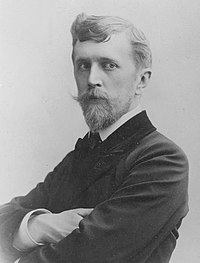
Ferdynand Ruszczyc h. Lis (1870–1936) was a painter, printmaker, and stage designer from Polish noble family of Clan Lis.
Biography
Born in the village of Bohdanów (then Russian Empire, now Belarus), Ruszczyc originally studied law at the University of St. Petersburg, but then switched majors and began taking painting classes at the Imperial Academy of Arts. He was a student of the famous Russian landscape painters Ivan Shishkin and Arkhip Kuindzhi. Ruszczyc travelled to the Crimea to paint seascapes, and later to the Baltic islands and Sweden to paint northern landscapes. He visited Berlin, where he was significantly influenced by the Symbolist painters such as Arnold Bocklin. After graduation, Ruszczyc made extensive tours of Western Europe incorporating much of the styles he came across into his own art.
Career

Together with Kazimierz Stabrowski, Xawery Dunikowski, Konrad Krzyżanowski and Karol Tichy, Ruszczyc helped develop the Warsaw School of Fine Arts, where he taught for a while. In 1907–08 he held the chair of landscape painting at the Kraków Academy of Fine Arts.
In 1908, with Józef Mehoffer, Ruszczyc organized an exhibition of Polish painting in Vienna. He then settled in Vilna (Vilnius), where he devoted himself to teaching. One of his students of that time was famous Russian and Soviet sculptor Isaac Itkind. Ruszczyc also organized cultural events, and worked as a graphic designer, poster designer and illustrator. As a costume designer, he participated in several performances of the municipal theater, and he was a member of the "Committee for the Conservation of the Adam Mickiewicz Monument". In 1918 and 1919 he participated in the founding of the Faculty of Fine Arts at Stefan Batory University, where he was elected as the first Dean. Czeslaw Znamierowski was one of his most notable students there.
Selected paintings
-
 Old apple trees
Old apple trees
-
 "Nec Mergitur"
"Nec Mergitur"
(It will not sink) -
 Forest Brook
Forest Brook
-
 Old House
Old House
-
 Soil
Soil
-
 Winter Landscape
Winter Landscape
-
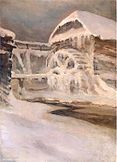 Mill in Winter
Mill in Winter
-
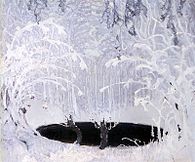 Winter Landscape
Winter Landscape
-
 Winter Landscape
Winter Landscape
-
 Coast of Crimea
Coast of Crimea
-
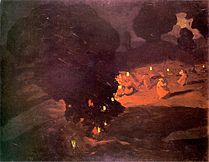 Saturday
Saturday
-
 Emptiness
Emptiness
-
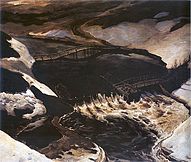 On the Banks of the Wilejka
On the Banks of the Wilejka
-
 Winter Landscape
Winter Landscape
-
 Sea and Rocks
Sea and Rocks
-
 Into the World
Into the World
-
 House in Bohdanow
House in Bohdanow
-
 The Old Nest
The Old Nest
References
- Anna Bernat, Ferdynand Ruszczyc, Edipresse Polska, 2007, ISBN 978-83-7477-221-1.
- "Ruszczyc, Ferdynand (1870–1936)". buffalo.edu.
- "The Land – Ferdynand Ruszczyc". Culture.pl.
- "National Museum in Warsaw, Ferdynand Ruszczyc". culture.pl. Archived from the original on 2015-10-06. Retrieved October 2014.
{{cite web}}: Check date values in:|accessdate=(help); Unknown parameter|deadurl=ignored (|url-status=suggested) (help) - "Ferdynand Ruszczyc". Culture.pl.
External links
[REDACTED] Media related to Ferdynand Ruszczyc at Wikimedia Commons
Categories: